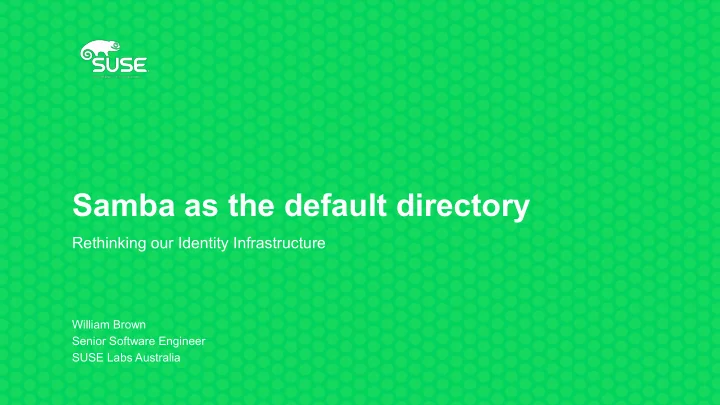

Samba as the default directory Rethinking our Identity Infrastructure William Brown Senior Software Engineer SUSE Labs Australia
ldapwhoami -D CN=William • displayName: Firstyear • o: SUSE Labs • c: Australia • st: Queensland • memberOf: O=389 Directory Server • drink: Iced Coffee • mail: wbrown@suse.de • preferredTimeZone: UTC+10:00 wbrown@suse.de
Progression of Servers wbrown@suse.de
What did this lead to? htoeuhtnaoeu wbrown@suse.de
How times have changed htoeuhtnaoeu wbrown@suse.de
Identity Management wbrown@suse.de
So how are people approaching this? wbrown@suse.de
So how are people approaching this? wbrown@suse.de
So how are people approaching this? SAML wbrown@suse.de
Where do we fit in? wbrown@suse.de
How should we think about this problem? • Humans and people at every level • Psychology and behaviours of people • SSH keys are paramount • Fits well with usability • Applications and servers are stateless • Automation and dynamic environments • BYOD is popular - and sometimes required • Return of the thin client wbrown@suse.de
How to achieve this with Samba? • Samba contains an LDAP server - let's use it! • It’s a replicated user and group database • Trust is based on CA (LDAPS) • SSSD + LDAPS for SSH keys distribution • OAuth for web application integration • Still integrates with RADIUS + enterprise applications • Doesn't change our existing static integrations wbrown@suse.de
Lets have some examples! /usr/local/samba/bin/samba-tool domain provision --server-role=dc --use-rfc2307 --dns-backend=SAMBA_INTERNAL --realm=SAMDOM.EXAMPLE.COM --domain=SAMDOM --adminpass=Passw0rd wbrown@suse.de
Setup anonymous binding /usr/local/samba/bin/samba-tool forest directory_service dsheuristics 0000002 --H ldaps://ldapkdc.example.com --simple-bind-dn='administrator@samdom.example.com’ wbrown@suse.de
Setup anonymous reads /usr/local/samba/bin/samba-tool dsacl set --objectdn=DC=samdom,DC=example,DC=com --sddl=‘(A;;RPLCLORC;;;AN)’ --simple-bind-dn=“administrator@samdom.example.com” --password=Passw0rd Repeat with: --objectdn=CN=Users,DC=samdom,DC=example,DC=com --sddl=‘(A;CI;RPLCLORC;;;AN)’ --objectdn=CN=Builtin,DC=samdom,DC=example,DC=com --sddl='(A;CI;RPLCLORC;;;AN)' wbrown@suse.de
Configure LDAPS Configure the files in /var/lib/samba/private and restart wbrown@suse.de
Configure Schema /usr/local/samba/bin/samba-tool fsmo show -H ldaps://ldapkdc.example.com --simple-bind-dn='administrator@samdom.example.com' --password=Password1 SchemaMasterRole owner: CN=NTDS Settings,CN=LDAPKDC,CN=Servers,CN=Default-First-Site- Name,CN=Sites,CN=Configuration,DC=example,DC=com wbrown@suse.de
Configure Schema [global] dsdb:schema update allowed = yes wbrown@suse.de
Add Schema dn: CN=sshPublicKey,CN=Schema,CN=Configuration,DC=adt,DC=blackhats,DC=net,DC=au changetype: add objectClass: top objectClass: attributeSchema attributeID: 1.3.6.1.4.1.24552.500.1.1.1.13 cn: sshPublicKey name: sshPublicKey lDAPDisplayName: sshPublicKey description: MANDATORY: OpenSSH Public key attributeSyntax: 2.5.5.10 oMSyntax: 4 isSingleValued: FALSE searchFlags: 8 dn: CN=ldapPublicKey,CN=Schema,CN=Configuration,DC=adt,DC=blackhats,DC=net,DC=au changetype: add objectClass: top objectClass: classSchema governsID: 1.3.6.1.4.1.24552.500.1.1.2.0 cn: ldapPublicKey name: ldapPublicKey description: MANDATORY: OpenSSH LPK objectclass lDAPDisplayName: ldapPublicKey subClassOf: top objectClassCategory: 3 defaultObjectCategory: CN=ldapPublicKey,CN=Schema,CN=Configuration,DC=adt,DC=blackhats,DC=net,DC=au mayContain: sshPublicKey dn: CN=User,CN=Schema,CN=Configuration,DC=adt,DC=blackhats,DC=net,DC=au changetype: modify replace: auxiliaryClass auxiliaryClass: ldapPublicKey wbrown@suse.de
Add SSH keys /usr/local/samba/bin/samba-tool user edit william -H ldaps://ldapkdc.example.com --simple-bind-dn='administrator@samdom.example.com' objectClass: ldapPublicKey sshPublicKey: ecdsa-sha2-nistp521 AAAA..... wbrown@suse.de
Configure SSSD - Part 1 [domain/samdom.example.com] ignore_group_members = False cache_credentials = True id_provider = ldap auth_provider = ldap access_provider = ldap chpass_provider = ldap ldap_search_base = dc=example,dc=com # This prevents an infinite referral loop. ldap_referrals = False # Enable AD UUID -> Uid mapping ldap_id_mapping = True ldap_schema = ad wbrown@suse.de
Configure SSSD - Episode 2 # Rather that being in domain users group, create a user private group # automatically on login. # This is very important as a security setting on unix!!! # See this bug if it doesn't work correctly. # https://pagure.io/SSSD/sssd/issue/3723 auto_private_groups = true ldap_uri = ldaps://ldapkdc.example.com ldap_tls_reqcert = demand ldap_tls_cacert = /etc/pki/tls/certs/ad_ldap.crt # Workstation access ldap_access_filter = (memberOf=CN=Workstation Users,CN=Users,DC=example,DC=com) wbrown@suse.de
Configure SSSD - The Finale ldap_user_member_of = memberof ldap_user_gecos = cn ldap_user_uuid = objectGUID ldap_group_uuid = objectGUID # This is really important as it allows SSSD to respect AD account locking ldap_account_expire_policy = ad ldap_access_order = filter, expire # Setup for ssh keys ldap_user_ssh_public_key = sshPublicKey # This is required for the homeDirectory to be looked up in the sssd schema ldap_user_home_directory = homeDirectory [sssd] services = nss, pam, ssh, sudo config_file_version = 2 domains = example.com [nss] homedir_substring = /home wbrown@suse.de
Configure SSH /etc/ssh/sshd_config AuthorizedKeysCommand /usr/bin/sss_ssh_authorizedkeys AuthorizedKeysCommandUser nobody test: /usr/bin/sss_ssh_authorizedkeys <username> wbrown@suse.de
Keycloak / Ipsilon wbrown@suse.de
What really underpins all of this? • Simple and generic will always win • Psychology and human interaction design principles • Empathy for our users and admins wbrown@suse.de
Future? wbrown@suse.de
Future wbrown@suse.de
wbrown@suse.de
wbrown@suse.de
What is next for OpenSource IDM? wbrown@suse.de
wbrown@suse.de
Recommend
More recommend